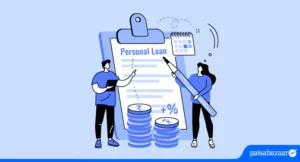Top Banks/NBFCs Offering Personal Loan for Travel – Paisabazaar
HDFC Bank
Up to ₹40L
10.9% - 24%
Upto 6 Years
₹6,500
Axis Bank
Up to ₹10L
10.49% - 22%
Upto 6 Years
Upto 2%
Kotak Mahindra Bank
Up to ₹35L
10.99% - 16.9%
Upto 6 Years
Upto 5%
IDFC FIRST Bank
Up to ₹10L
10.7% - 23.99%
Upto 5 Years
Upto 2%
ICICI Bank
Up to ₹50L
10.8% - 16.5%
1-6 Years
Upto 2%
What is a Travel Loan?
A travel loan, also known as vacation loan or holiday loan, is a personal loan variant offered specifically for covering travel or holiday expenses. The other features of travel loans, such as their interest rates, tenures, processing fees, unsecured nature, etc are the same as regular personal loans.
Travel Loan Interest Rate in India
Very few lenders offer unsecured travel loans as a separate loan category. Even lenders which do, usually charge the same interest rates as their regular personal loans, which usually starts from 10.50% p.a. Moreover, the proceeds of regular personal loans can be used for financing travel-related expenditures. Hence, prospective applicants should compare personal loan interest rates offered by various lenders to find the best deal for financing their travel plans.
Personal Loan for Travel – How Much Can You Borrow?
The maximum loan amount offered to a travel loan applicant would primarily depend on his/her repayment capacity, subject to the upper limits set by the lender. When determining the maximum eligible loan amount, some lenders use methods like the EMI/NMI Ratio, wherein the total EMI obligations should not exceed a predetermined proportion, usually 50-60% of the applicant’s monthly income. Other lenders use the Multiplier Method, wherein the loan amount is determined based on a pre-set multiple, ranging from 10 to 24 times, of an applicant’s net monthly income. Some lenders may use a combination of both methods to determine the maximum loan eligibility.
Tips to Get Travel Loans at Lower Interest Rates
To secure personal loans for travel at low interest rates, follow these tips:
- Maintain a credit score of at least 750
- Check for pre-approved personal/travel loan offers from banks and NBFCs
- Check for personal/travel loan offers from lenders where you hold deposits or have existing loans/credit cards
- Keep a track of interest rate concessions offered during festive season
- Compare loan offers from multiple lenders on online financial marketplaces
Documents Required for Availing a Travel Loan
The documents required to apply for unsecured travel loans or personal loans for travel are more or less the same across lenders. A few common documents are listed as below:
- Proof of Identity: Passport, voter ID, driving license, Aadhaar card or PAN card
- Proof of Residence: Aadhaar card, voter ID, passport or utility bills
- Proof of Income:
- For Salaried: Salary slips, bank statements, Form 16
- For Self-employed: Previous years’ ITR, P&L statement and balance sheet, bank statements
Personal Loan for Travel – Eligibility Criteria
The eligibility criteria set for travel loans is more or less same as that of personal loans. Here are some of the common set of eligibility criteria used by most lenders:
- Age: 18 – 60 years
- Salary: At least Rs 15,000 per month for salaried customers
- Income: At least Rs 5 lakh p.a. for self-employed customers
- Credit Score: Preferably 750 and above
- Employment Stability: Usually 1 year with some lenders requiring longer work experience
- Business Continuity: Usually 3 years of business continuity with some lenders requiring longer period of business continuity
- Employment Type: Salaried employees working with government, public sector undertakings, MNCs and other reputed corporates
Travel Loan vs. Credit Card Loan – Which is Better?
The interest rates of a credit card loan is usually higher than personal loan interest rates offered by any lender to the same individual. Thus, the borrowing cost would be higher for those availing credit card loans for their travel expenses.
As credit card loans are essentially pre-approved in nature, they are usually disbursed within a few hours or at least on the same day of making the loan application, with zero documentation. Thus, those who are ineligible for pre-approved personal loans or if the turnaround time of the offered personal loan is not matching their requirements should consider availing credit card loans.








